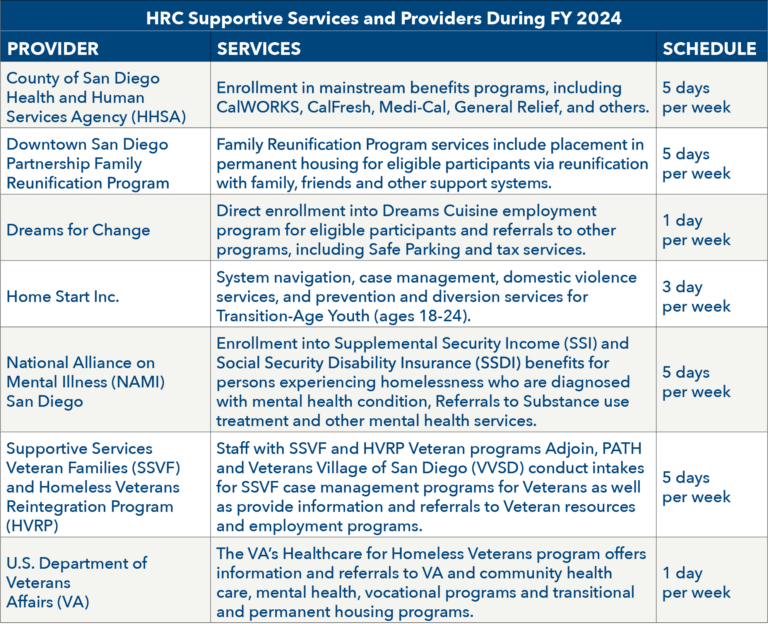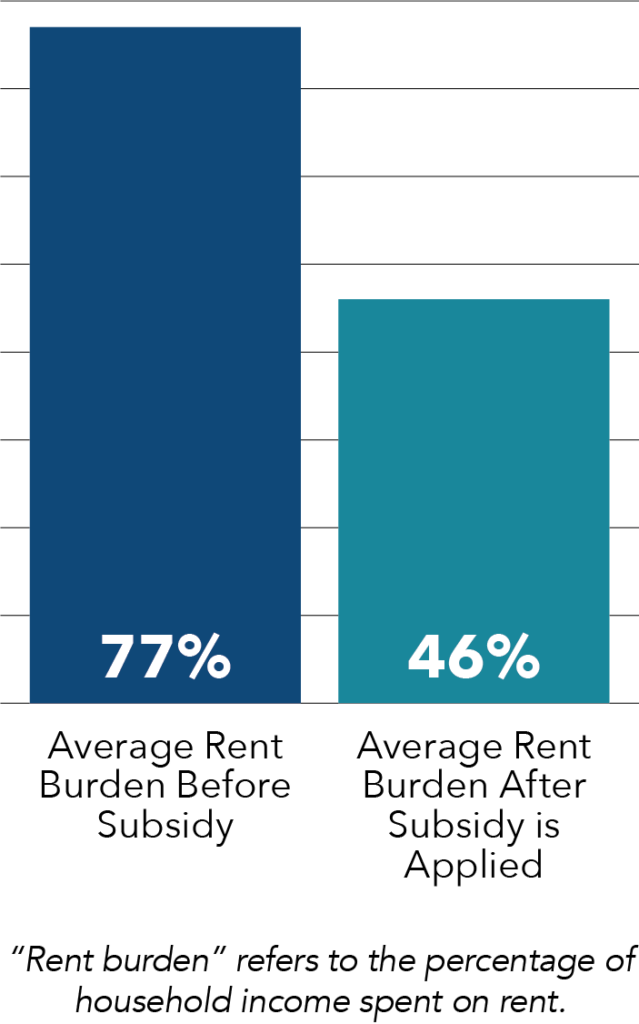HOMELESSNESS SOLUTIONS
The San Diego Housing Commission (SDHC) administers programs and collaborates with the City of San Diego, the County of San Diego, the San Diego Regional Task Force on Homelessness (RTFH), federal and state government agencies, homelessness service providers, landlords, developers and community organizations on a variety of programs to address homelessness in the City of San Diego.
SDHC remains a leader in collaborative efforts to address homelessness, such as the Community Action Plan on Homelessness for the City of San Diego; SDHC’s homelessness initiative, HOUSING FIRST – SAN DIEGO; and SDHC’s administration of homelessness shelters and services programs for the City.
Community Action Plan on Homelessness
Four years after the San Diego City Council accepted the Community Action Plan on Homelessness for the City of San Diego (Community Action Plan), an updated analysis of the crisis response and housing needs to address homelessness in the City was completed during Fiscal Year 2024.
The update, presented to the San Diego City Council on November 14, 2023, highlighted progress achieved from 2019 to 2023 and identified revised shelter and housing needs for the years to come. SDHC, the City’s Homelessness Strategies and Solutions Department, the San Diego Regional Task Force on Homelessness (RTFH), and the Corporation for Supportive Housing (CSH) jointly presented the update.
The Community Action Plan is a comprehensive, 10-year plan that builds on progress, lays out short-term achievable goals, and serves as a guide for long-term success in addressing homelessness. SDHC was one of the lead agencies in the creation of the Community Action Plan.
The San Diego City Council accepted the Community Action Plan on October 14, 2019.
Progress Since 2019

Permanent Supportive Housing
Permanent supportive housing is long-term rental assistance paired with intensive wraparound supportive services to help maintain housing stability for households that experienced homelessness and have long-term disabilities, extensive service needs, and lengthy or repeated episodes of homelessness.
SDHC awards rental housing vouchers to developers or service providers to help pay rent for individuals and families who experienced homelessness and receive access to supportive services through their residence or the service provider. Through the Veterans Affairs Supportive Housing (VASH) voucher program, SDHC partners with the U.S. Department of Housing and Urban Development (HUD) and the U.S. Department of Veterans Affairs (VA) to provide rental assistance to veterans experiencing chronic homelessness. These veterans receive clinical health and case management services from the VA San Diego Healthcare System.
Additionally, SDHC receives HUD Continuum of Care program grants that fund 11 permanent supportive housing programs. They provide rental assistance for more than 275 units. These programs are operated by eight homelessness service providers: Father Joe’s Villages, Housing Innovation Partners, Townspeople, TURN Behavioral Health Systems, Home Start, Inc., South Bay Community Services Corporation, Pathfinders, and The San Diego LGBT Community Center.
To me, this place is a blessing.”
—Emily
Freedom for a Mother and her Children
Floating from the walls of Emily’s two-bedroom apartment at Milejo Village, developed in collaboration with SDHC, is a vibrant swarm of hand-crafted butterflies that she says represents the freedom she and her family feel after years experiencing homelessness.
“When we stepped into this building, I felt that it was a new beginning,” Emily said. “I know that I have told myself that I can’t look back on the past. From this moment on, I have to learn to just focus on looking forward and to the new things that’s ready to come, where I don’t have to be so stressed whether I’m going to go into another tent or another motel or another program.”
Emily said that as a girl growing up in the Philippines, she lost her parents as an infant and lived in an orphanage until she was in sixth grade. She and her brother were then adopted and moved to the United States, but she retained the inner trauma of her difficult life.
As a mother with two children, she moved to San Diego in 2017, but after a few months, she was living in tents, moving in and out of motels, and shuffling between programs, with “anger issues” getting in the way of any sustained progress.
Emily said her situation improved at the San Diego Rescue Mission, where she was “grateful” to share one bed with her two girls.
Next, she was able to obtain a home at Milejo Village, developed by Jamboree Housing Corporation in collaboration with SDHC. SDHC awarded 64 housing vouchers to the development to help residents like Emily pay their monthly rent. SDHC also supported the development with a $4.2 million loan, consisting of federal, state and local funds SDHC administers.
At Milejo Village, Emily’s daughters, ages 11 and 6, share a bedroom, and she has one of her own. They have their own bathroom and a kitchen stocked with appliances for Emily to cook for the family.
She’s now able to focus on being a mother to her kids, filling her balcony with succulents, and creating brightly colored artwork using repurposed items—featuring her beloved butterflies—to express her freedom and individuality.
“Me and my kids are just like loving art,” she said. “And it truly, to me, this place is a blessing.”
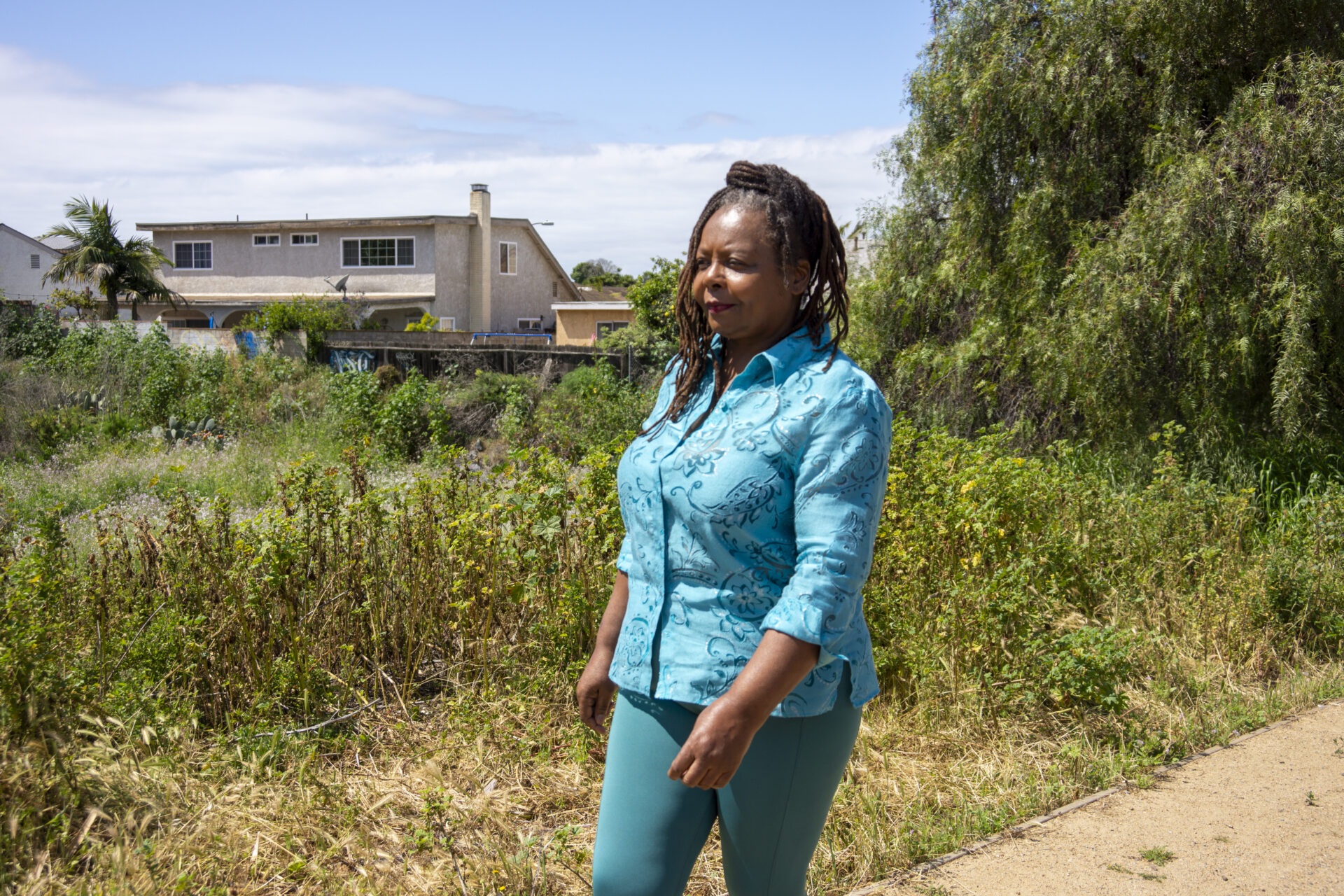
A Safe, Affordable Home for a Senior
After sleeping in her vehicle for more than a year, Teretha says she feels hope and “the joy of being inside once again” in her apartment at Nestor Senior Village, developed in collaboration with SDHC.
“My family is at ease now that I’m not sleeping in my car,” Teretha said. “My daughter, my brother, my niece, they have all came over, and they love my place. They love it, and they’re just happy for me that I’m in a safe place now.”
After an eviction forced her from an apartment building where she’d lived nearly 40 years, Teretha started living in her car. For more than a year, she would park outside of retail stores, libraries and on the street to sleep in the backseat.
The experience exacerbated her arthritis and left her knees and ankles swollen. She also had a stint in the hospital for heat stroke.
While using one of the City of San Diego’s safe sleeping sites, Teretha was introduced to two San Diego-area nonprofits: People Assisting the Homeless (PATH) and Alpha Project. Their assistance opened doors for her to launch a search for a new apartment.
When she got a call about an opening at Nestor Senior Village, developed by National CORE, she sprung at the opportunity. Nestor Senior Village provides affordable housing with supportive services for seniors ages 55 and older who experienced or were at risk of homelessness.
SDHC awarded 73 rental housing vouchers to the development to help residents, including Teretha, pay their rent. SDHC also awarded a $3.3 million loan to support the development.
At Nestor Senior Village, Teretha has a fully furnished studio apartment where she cooks for herself, sleeps comfortably in her own bed, and uses the property’s amenities, including its community center.
“I never thought I would be homeless and being out in the cold or being out in the heat,” she said. “There’s times that I didn’t leave my apartment for two weeks by choice because I had everything in there. And to be homeless was really, really hard for me. And now that I’m not homeless and back in a nice apartment, I’m OK with myself now.”
My family is at ease now that I’m not sleeping in my car.”
—Teretha
State Homekey Funds
During FY 2024, the State of California awarded $55.75 million from the third round of Homekey funding to SDHC, in collaboration with the City of San Diego and County of San Diego. These awards support projects to create 236 new affordable housing units with supportive services for people experiencing homelessness.
The amount awarded to SDHC was $14.65 million more than the State originally had allocated for the San Diego region through this round of Homekey funding.
Overall, since Homekey launched in 2020, the State has awarded more than $105 million to SDHC collaborations with the City and County to create more than 600 affordable housing units with supportive services for people experiencing homelessness. Through its purchases with these funds, SDHC owns more than 550 of these units.
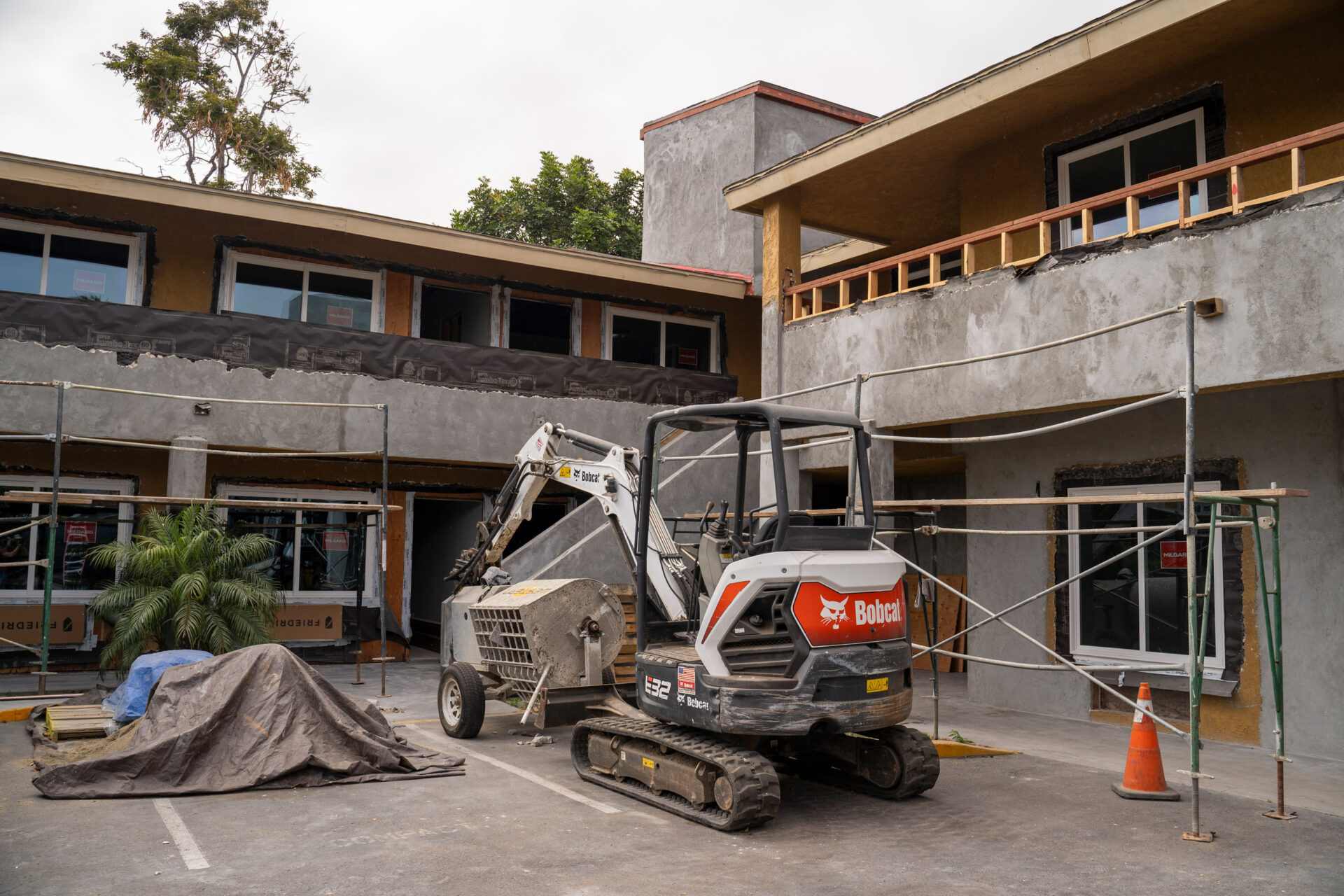
UPDATE: Property Rehabilitation Underway
The property rehabilitations necessary to convert two Homekey-funded projects—Pacific Village and Presidio Palms—are underway and expected to be completed in spring 2025.
Pacific Village
SDHC completed its purchase of Pacific Village at 3737-3747 Midway Drive in January 2024. Shortly thereafter, SDHC used this property to provide emergency, short-term lodging for families in the City who were displaced from their homes by the January 22, 2024, catastrophic floods.
Rehabilitation on Pacific Village began March 25, 2024, and is expected to be completed in time for individuals to begin residing there by February 2025.
Presidio Palms
SDHC completed its purchase of Presidio Palms at 2087 Hotel Circle South in August 2024. Rehabilitation work began in October 2024 and is anticipated to be completed by spring 2025.
HOUSING FIRST – SAN DIEGO
SDHC’s homelessness initiative, HOUSING FIRST – SAN DIEGO, creates housing solutions for people experiencing or at risk of homelessness. It has three major areas of focus.
- Direct Client Services Programs: SDHC operates programs that directly assist individuals and families with a wide range of services and financial assistance needs.
- Development Funds with Housing Vouchers: SDHC awards development funds combined with federal housing vouchers for the creation, rehabilitation or acquisition of permanent supportive housing for individuals and families with very high service needs and who receive ongoing financial assistance.
- Special Program Housing Vouchers: SDHC administers special program housing vouchers and housing assistance programs that provide ongoing rental assistance and wraparound services in collaboration with community nonprofit organizations and agencies for a variety of special populations.
Peace of Mind for a Mother of Two
After sleeping in her car and struggling to pay down debt, Leslie has a fresh start with her two daughters in a two-bedroom apartment in southern San Diego thanks to a federal Emergency Housing Voucher (EHV) from SDHC that helps pay their rent.
“The way I felt when they told me about everything at first, I was not trying to get excited or like tell my girls because I was like, ‘What if it doesn’t come through?’” Leslie said. “But when they gave me the keys for the apartment, and they told me, ‘Here, you could come in,’ I was happy. I was like, ‘This is my own place.’ I could afford it.”
Homelessness for Leslie and her daughters, Amber and Camila, followed a divorce in which Leslie took on the car payment and cost of rental housing. This left Leslie “drowning in debt” and led to an eviction, she said.
“That’s when I started couch hopping and going in my car,” she said. “It was like two, three years I lasted like that.”
Leslie said she couldn’t give her girls the life they deserved in that situation. But a social worker referred Leslie to SDHC, and she received an EHV.
EHVs assist people experiencing homelessness; at risk of homelessness; fleeing or attempting to flee domestic violence, dating violence or sexual assault, stalking or human trafficking; or who recently experienced homelessness and for whom rental assistance will help prevent homelessness or a high risk of housing instability.
Leslie’s landlord also participates in SDHC’s Landlord Engagement and Assistance Program (LEAP), which provides incentives for landlords in the City of San Diego who rent to San Diegans experiencing homelessness.
“I got this apartment, which like changed my whole world,” Leslie said.
SDHC staff meets with Leslie monthly to discuss finances and how to save her money. She also received help from SDHC to furnish the apartment with beds and a couch for the living room. Swimming at the apartment community’s pool and family movie nights are among their favorite pastimes at their rental home.
“My family tells me a lot, ‘You have a different glow in you. You look different,’” Leslie said. “Well, of course. I’m grateful. I’m grateful because I have a house; I have a roof over my girls. … I’m happy, and my girls are happy, and that’s what matters.”
I got this apartment, which like changed my whole world.”
—Leslie
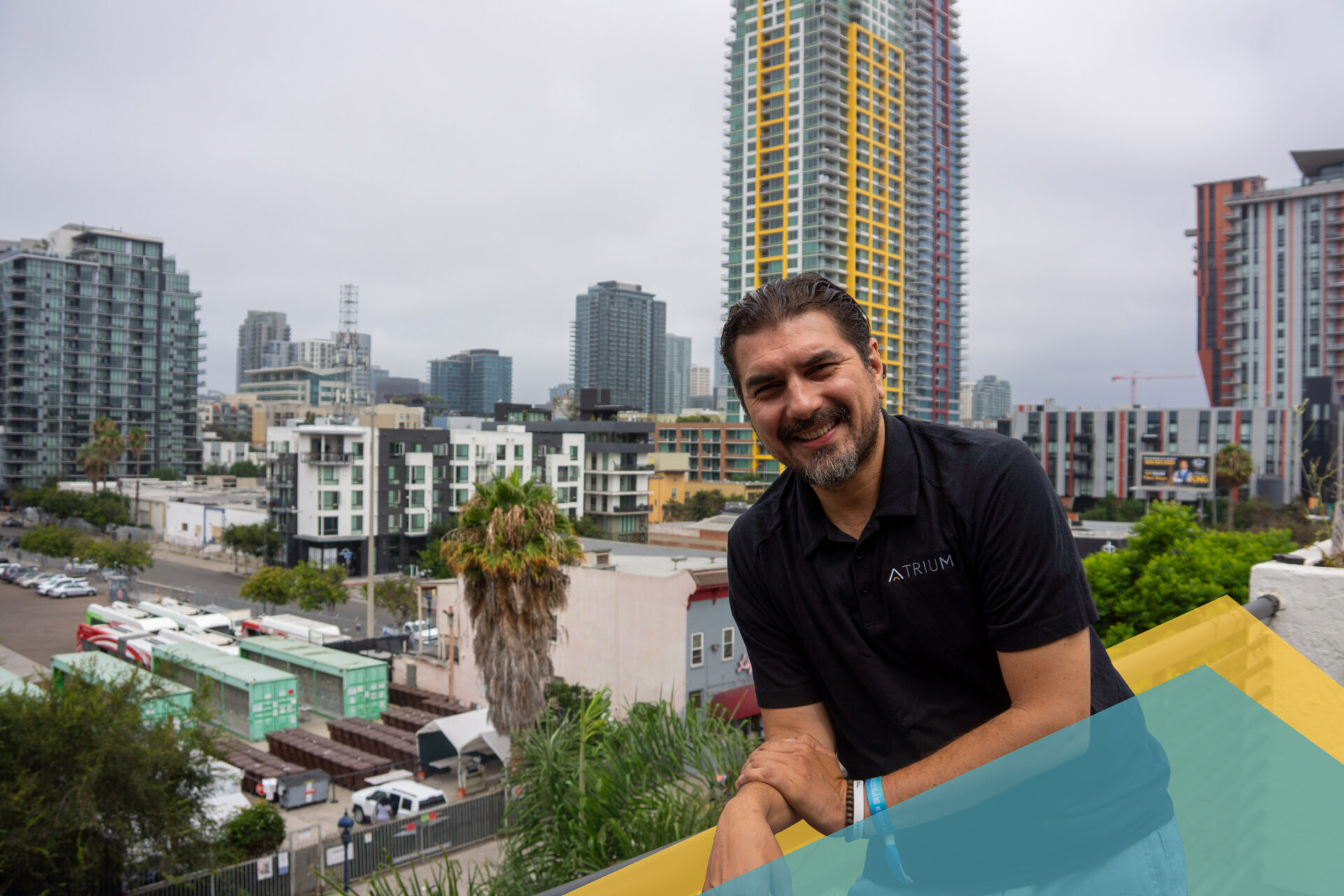
An ‘Open-Minded and Open-Hearted’ Business Model
For Daniel Fellus, being a residential property owner is both a business and an opportunity to have positive impact on the lives of people struggling to find a place to live that they can afford in San Diego. That is why he participates in SDHC’s Landlord Engagement and Assistance Program (LEAP).
“We realize that we are giving people a space where they’re gonna have memories,” Fellus said. “Could be the birth of a child. It could be a holiday. It could be an engagement. It could be anything. It’s not just four walls and the ceiling collecting the rent. So, if you work with that mindset—if you have that mindset—you really will be successful in what you’re doing here.”
Fellus’ company acquired the former Ballpark Place apartments in January 2023 and renamed it Atrium Apartments. They upgraded the site with fresh paint throughout, jetted plumbing pipes, and installed a new elevator, an exterior awning fronting 16th Street, and an enhanced security system, among other improvements.
They wanted to stabilize the building, he said, and that includes renting to new tenants through LEAP and to households with federal Section 8 Housing Choice Vouchers. LEAP provides incentives and benefits to landlords who rent to San Diegans experiencing homelessness, as well as housing location and financial assistance for prospective tenants to pay housing-related costs, such as security deposits and application fees.
Fellus said LEAP gives landlords “peace of mind” with a contingency fund that helps landlords cover expenses such as repairs that exceed security deposits.
“What LEAP has done was enhance communities, and (it’s) given people a chance,” he said. “I see here a family of kids, mom, father and children, and it’s a beautiful thing that they are housed, and they don’t have to worry about it.”
Fellus also appreciates incentive payments made to landlords through LEAP—$500 for the first apartment rented to a family or individual experiencing homelessness and $250 for each additional unit. That money typically goes back into the building for improvements, he said. Fellus encourages other landlords to explore the benefits of LEAP in their own buildings.
“We should be open-minded and open-hearted to extend our business models to other communities,” he said. “Whether it’s low income—and some residents have no income—don’t let the fear of the unknown stop you from actually building a community and helping people with housing.”
We should be open-minded and open-hearted to extend our business models to other communities.”
—Daniel Fellus
Housing Vouchers for People Experiencing Homelessness
Federal rental housing vouchers are among the resources SDHC has awarded or committed to create permanent housing solutions for people experiencing homelessness. Approximately 34% of SDHC’s rental housing vouchers are committed to addressing homelessness.
A Family United
Phillip and Yazmin moved into an affordable rental apartment just in time—a day before Yazmin gave birth to their daughter, Hailey. Rental assistance from SDHC made it possible.
“The Housing Commission helps us with the rent. They helped me trying to get into this place. They did a lot for us to be here, “ Phillip said. “If it wasn’t for them, then we, we would still be on the streets for right now.”
The days leading up to Hailey’s birth were stressful for the family. At the time, homelessness separated them. Phillip slept on the street near the restaurant where he worked in Mission Valley. Yazmin and the children lived in a shelter downtown.
Working with a caseworker from Alpha Project, in collaboration with SDHC, the family was able to bring their baby girl and their three boys home to a three-bedroom rental apartment in Mission Valley, close to Phillip’s job at the restaurant, where he was named employee of the year.
“We have our own apartment. We watch movies. … We can play in the living room. Back then, we couldn’t. Now we can, like, make our own food, you know, late night snacks, just enjoying the opportunity of being with my kids,“ Phillip said.
Phillip’s history with homelessness began early and spread out over the years. He ran away from home many times and became addicted. He credits meeting Yazmin on a trolley, their relationship, and their kids with helping him turn his life around to provide for his family.
With stable housing, Phillip is focusing on the future. He would like to be a manager at work one day. He would like to be able to give a struggling person a job and the opportunity to get ahead, just like the manager who hired him.
Although his work ethic remains strong—he describes himself as a bit of a “workaholic”—Phillip is focusing his free time on being there for his family.
He cherishes waking up to his son’s caress, caring for the baby, keeping food in the refrigerator, and having the opportunity to provide for the needs of his family.
“I got the most beautiful family in the world,” Phillip said. “I got my daughter, my son and my step kids too. … I’m living the dream.”
I’m living the dream.”
—Phillip
Homelessness Response Center
The City of San Diego Homelessness Response Center (HRC) provides a broad range of services to help individuals and families experiencing homelessness on their path to permanent or other long-term housing. SDHC operates and administers the HRC, in collaboration with the City of San Diego, People Assisting the Homeless (PATH), the RTFH, and homelessness service providers.
FY 2024
Duplicated count includes individuals who visited HRC more than once. Services can include needs assessments, resource referrals, connections to case management, system navigation and stability services.
672
Estimated number of individuals connected to on-site service provider partners
438
Estimated number of individuals enrolled in services provided by PATH San Diego
Coordinated Shelter Intake Program
SDHC operates the Coordinated Shelter Intake Program, which facilitates referrals to participating shelters in the City of San Diego to identify a bed that best meets the individual’s needs. The program provides a uniform workflow and a single point of contact, so those seeking shelter can be matched quickly to a shelter that best meets their needs, when beds are available..
SDHC’s Coordinated Shelter Intake Team facilitates intakes in conjunction with City-funded outreach teams, including the San Diego Police Department Neighborhood Policing Division’s Homeless Outreach Team (HOT) and Homelessness Response Center staff. Intakes are facilitated seven days a week, except for City-observed holidays, when direct referrals to shelters are available. SDHC staff review referrals and match clients with the available and most appropriate shelter intervention.
Most Frequent Reasons for Incomplete Referrals – FY 2024
The incomplete reason “Other” includes intakes suspended to support households exiting County of San Diego Emergency Temporary Lodging Program, beds offline due to repairs; couples unable to stay together; hospitalizations; staffing shortages; or missing client data for placement.
New Funding for Outreach and Shelter
LGBTQ+ Affirming Shelter
Federal funding to convert underutilized SDHC office space into a homelessness shelter for transition-age youth was formally announced at a news conference April 26, 2024, at SDHC’s offices. U.S. Representative Scott Peters, who helped secure $1.5 million in federal community project funding for the office conversion, was joined at the news conference by Mayor Todd Gloria, City Council President Sean Elo-Rivera, City Councilmember Stephen Whitburn, SDHC President and CEO Lisa Jones, and San Diego LGBT Community Center Chief Operating Officer Beth Davenport. U.S. Senator Alex Padilla also included this federal funding in his community projects funding request. Through a contract with SDHC, the LGBT Community Center operates the shelter program, in partnership with San Diego Youth Services and the YMCA, with 22 beds at two interim sites. The conversion of SDHC’s office space will provide a long-term home for the program with approximately 43 shelter beds. The program serves any transition-age youth experiencing homelessness, but it is the first program of its kind in San Diego to tailor its services specifically to affirm transition-age youth who identify as part of the LGBTQ+ community.
Multidisciplinary Outreach
On October 5, 2023, California Assemblymember Brian Maienschein, Mayor Todd Gloria and City Council President Sean Elo-Rivera announced $750,000 in state funding to support the Multidisciplinary Outreach Program in the City. Assemblymember Maienschein advocated and secured the funds in the state’s 2023-2024 budget. SDHC launched the Multidisciplinary Outreach Team in 2022 with funding the San Diego City Council allocated specifically for that purpose. SDHC contracts with People Assisting the Homeless (PATH) San Diego to operate the program. PATH subcontracts with Father Joe’s Villages for a healthcare component of the program. The Multidisciplinary Outreach Program serves individuals and families who are among the most vulnerable people experiencing unsheltered homelessness in the City. The program focuses on people experiencing unsheltered homelessness who are among the highest utilizers of the criminal justice, emergency services or homelessness services systems. The additional funding from the State will enable the program to assist additional individuals experiencing homelessness.
Housing Instability Prevention Program
How It Works
- Households that need assistance call (619) 578-7768, SDHC’s HOUSING FIRST – SAN DIEGO hotline.
- SDHC provides enrolled households with $250, $500 or $750 per month toward their rent, depending on the household’s circumstances.
- HIPP assists with housing-related expenses, such as past-due rent and past-due utilities, depending on the household’s need. These payments are made directly to the landlord or utility company.
- HIPP also provides case management. Case managers work with the household to create a housing stability plan, to identify opportunities to increase household income, to make referrals to community-based resources and any other solutions to stabilize their housing.
- Enrolled households receive assistance for up to 24 months.
Eligibility Criteria
- Live in the City of San Diego
- Spending more than 40 percent of their gross income on housing in San Diego.
- Experiencing a housing crisis, such as facing eviction, and is at risk of homelessness.
- No alternative housing options.
- Lack the money and support network to resolve their housing crisis.
- Household income is at or below 80 percent of San Diego’s Area Median Income, currently $121,250 per year for a family of four.
- Assets such as bank accounts or retirement savings that total less than $2,000.
- Do not currently receive ongoing rental assistance from another program.
- Immigration status does not affect eligibility for this program.
- Additional criteria apply.
Priority Populations
- Seniors aged 55 and older
- People of any age with a disability
- Families with a child aged 17 and younger
- Transition-age youth between the ages of 18 and 24
September 8, 2022 – June 30, 2024
They came through for us. It was really good.”
—Joseph
A ‘Lifeline’ for a Couple In Crisis
Facing a financial crunch exacerbated by their health challenges, Marc and Joseph were able to reclaim their lives and stabilize their budget with help from the Housing Instability Prevention Program (HIPP), which SDHC operates for the City of San Diego.
“What was going through my mind was I was desperate,” said Joseph, who goes by “J.” “We needed help, and I just wanted to see what could happen. All they could do is say ‘no,’ and, you know, we’d have to find something else to do. But they came through for us. It was really good.”
The couple have lived in the same University Heights apartment for the past 10 years. Two years ago, J said he lost his job of nearly two decades in the printing business amid difficulties with his diabetes.
“And then right after he got sick, I got sick,” Marc said. “I had a stroke—two strokes. That was scary because I was paralyzed on the second one a little bit. That kind of got me. I didn’t know what we were gonna do after that.”
Marc and J said they were spending 96% of their income on rent. They were struggling to pay bills, using credit cards to fill in the gaps, and feared becoming homeless if they lost their apartment, J said.
J called 211 San Diego, and they were connected to HIPP, which J and Marc described as a “lifeline” for them.
HIPP helps pay rent and other housing-related expenses for City of San Diego households with low income, experiencing a housing crisis or at risk of homelessness.
As the percentage of their income going to rent decreased, they’ve worked with an SDHC case manager to help manage their finances.
“The Housing Commission, they really helped us out a lot with everything,” J said. “I used to just give (Marc) the money and not worry about the bills. I was just working. Now you figure out, ‘OK when’s this bill due?’”
With their situation more settled, they were planning to move to a new apartment a short distance from where J grew up in Lemon Grove.
They’re grateful for the assistance from HIPP and recommend it to others.
“Take a chance,” Marc said. “You’re never gonna know unless you do it. … It’s not gonna be an easy fix. No. Is it worth it in the long run? Yes.”
Seniors Safe at Home Program
HIPP served as a model for the creation of a new, similar program announced September 29, 2023, to assist seniors. Seniors Safe at Home helps pay rent and other housing-related costs for seniors aged 55 and older with low income, experiencing a housing crisis, and at risk of homelessness. Serving Seniors provides case management services to enrolled households. Case managers work with the household to create a housing stability plan, to identify opportunities to increase household income, to make referrals to community-based resources and any other solutions to stabilize their housing. This is a collaboration among SDHC, Serving Seniors and The Lucky Duck Foundation, which invested $500,000 in philanthropic funds for the program.
September 29, 2023 – June 30, 2024
Eviction Prevention Program
The City of San Diego Eviction Prevention Program (EPP) helps renters with low income in the City of San Diego who are facing eviction for not paying their rent. Legal Aid Society of San Diego operates EPP through a contract with SDHC.
Eligibility
Eligible tenants must:
- Reside at a City of San Diego address
- Have a household income at or below 80 percent of San Diego’s Area Median Income ($121,250/year for a family of four in 2024)
- Have an obligation to pay rent
Types of Legal Assistance Available
- Full legal representation for eligible tenants throughout the pre-eviction and eviction process, in settlement negotiations and through trial, if necessary.
- Limited legal services for eligible tenants through clinics, hotlines or appointments (virtual or in person), such as help with:
- Submitting formal responses to eviction notices
- Formal responses to Unlawful Detainers
- Requests for reasonable accommodations
199
Eligible Tenants Receiving Full Legal Assistance
FY 2024
1,623
Eligible Tenants Receiving Limited Legal Assistance
FY 2024
1,651
Additional Services Provided to Eligible Tenants with Low Income
FY 2024
540
Referrals to Other Community Resources
FY 2024




